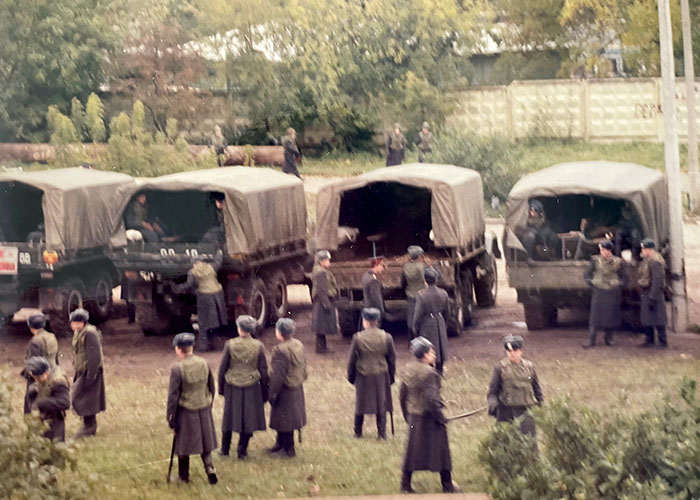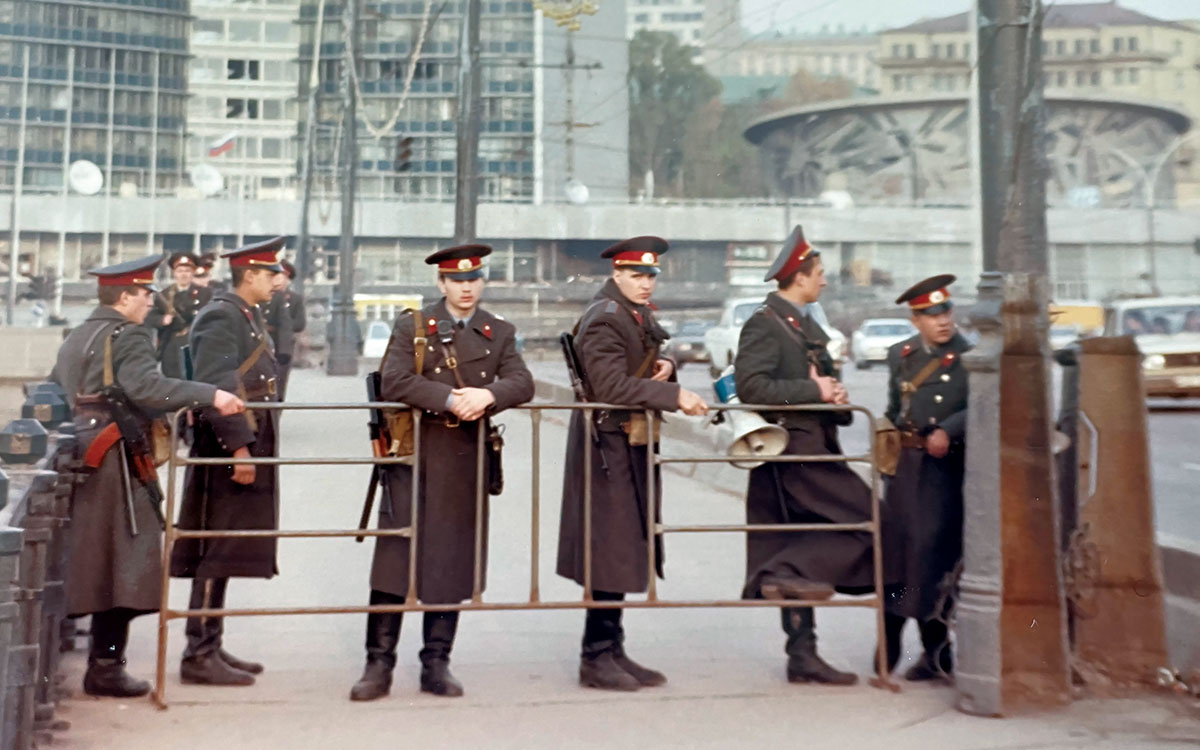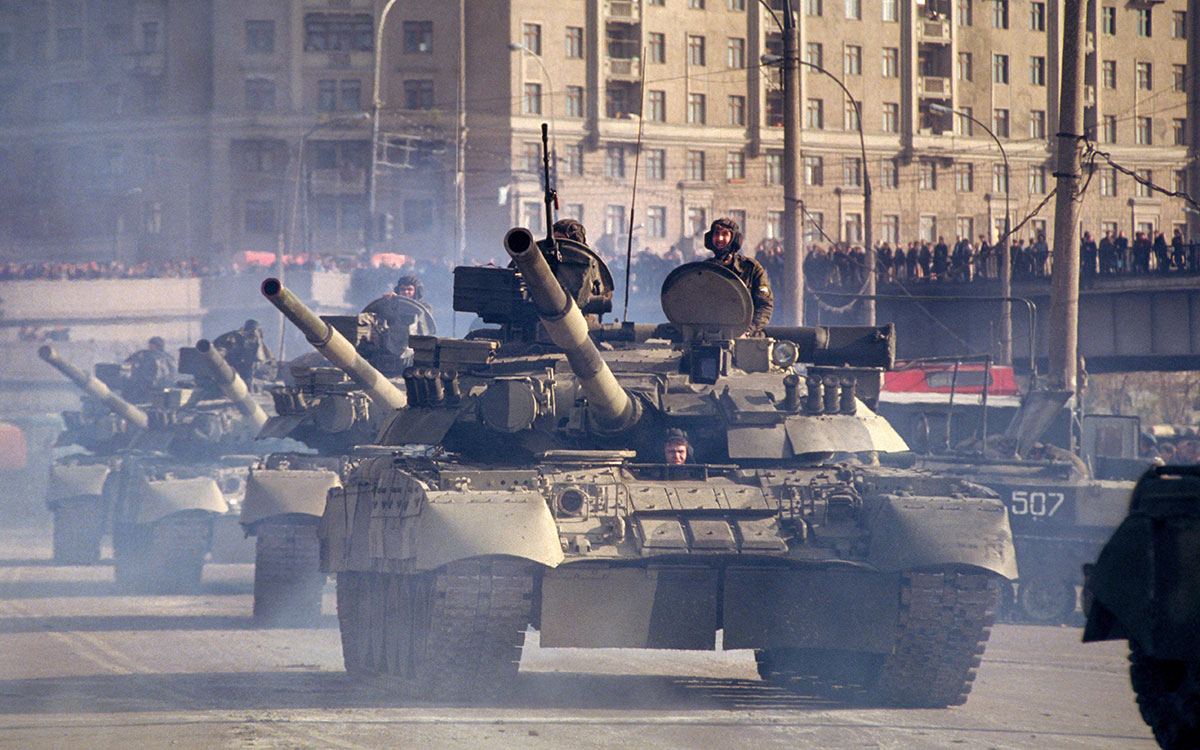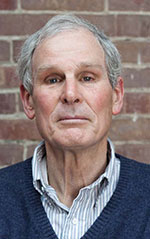Crisis at the Russian White House, 1993
On the 30th anniversary of what Russians call the “October Coup,” a veteran FSO offers an inside view of the fateful standoff between the president and the legislature in Moscow.
BY LOUIS D. SELL

Interior Ministry troops assemble near the Russian White House during the 1993 constitutional crisis.
Courtesy of Louis Sell
Sunday, Oct. 3, 1993, was the kind of unusually warm and sunny fall day that Muscovites cherish. Having essentially been on full-time duty as acting number two at the embassy since the crisis began in September, I decided to take my wife, Cathey, my 8-year-old daughter, Elizabeth, and one of her friends for a picnic on the outskirts of Moscow. That excursion turned out to be a big mistake, only mitigated by the fact that almost everyone else in Moscow, from Boris Yeltsin on down, was as surprised by what happened as I was.
“Got a cigarette?” the young Russian special forces sergeant drawled as he leaned his Kalashnikov casually across our open van widow. A dozen other soldiers walked warily behind two armored vehicles withdrawing slowly down the center of the unnaturally empty Moscow ring road. Weapons at the ready, their eyes searched the nearby buildings with the taut alertness of men who have recently been fired on and expect it could happen again. Trying not to look nervously at my wife and the two little girls in the back, I asked what was happening. “Who knows,” he replied. “Some kind’a ruckus. We’re getting out.”
From there, I drove a few hundred yards through a milling crowd to the American embassy. Recognizing me, Marine guards arrayed unusually in helmets and flak jackets opened the gate just wide enough for us to enter. Once inside the compound, while my wife and the children dashed for our residence, I hustled into the command post that the embassy had been maintaining near my office in the political section for the past two weeks—since Russian President Boris Yeltsin had dissolved the country’s hardline parliament. When the delegates refused to disband, Yeltsin surrounded them in the “White House” where only two years previously he, with parliamentary chief Ruslan Khasbulatov at his side, had led resistance to the August 1991 coup against Soviet President Mikhail Gorbachev.
Yeltsin’s action was clearly outside the law, but for the past two years the parliament had been sabotaging his reform program with a vehemence that, in recent months, had blocked all normal functions of government. Since the White House was only 200 yards behind the U.S. embassy, we had found ourselves participants in the drama from its beginning. Despite the annoyance, inconvenience, and eventually danger of being at the epicenter of what turned out to be an armed conflict, embassy personnel and their families pulled together to meet the challenge.

Russian police at the barricades in central Moscow in October 1993.
Courtesy of Louis Sell
In the command post, my deputy, Judy Mandel, an experienced Soviet hand who spoke fluent Russian, and the embassy security officer briefed me on what we knew and didn’t know—mainly the latter at that point. Mid-afternoon, a crowd of several thousand had unexpectedly come marching down the ring road and attacked police barricades from behind. Simultaneously, armed men, led by Vice President Aleksandr Rutskoy, had swarmed out of the White House. After a brief firefight, most of the police had fled, but some had been killed and others had surrendered. While this was going on, embassy personnel had quietly brought inside the uniformed Soviet guards outside the main gate and let them out via a back entrance, thereby probably saving their lives.
Flushed with the enthusiasm of unexpected victory, the crowd was a motley collection of old-style communists, Russian nationalist extremists, swastika-toting Nazis, and leather-jacketed skinheads looking for a fight and not very particular against whom. About the only thing that united them was their hatred for Boris Yeltsin—and the United States.
At the point where it faces the White House, the embassy compound is protected by a brick wall about seven feet high. It was regularly climbed by drunks or thrill-seekers; on one occasion a confused but otherwise seemingly harmless Russian intruder was found taking a shower in the basement of the embassy townhouse belonging to the deputy chief of mission (DCM).
After milling about and making their views on America abundantly clear through shouts and gestures, the crowd moved away. On the open line to the State Department’s Operations Center, I briefed Strobe Talbott, ambassador-at-large and special adviser to Secretary of State Warren Christopher on the Newly Independent States. It took only a few words for Talbott to understand the gravity of the situation. He asked what we needed, and I urged him to remind the Russian authorities of their obligation to provide protection for the embassy.
My next task was to inform Ambassador Thomas R. Pickering who, like most of the rest of Moscow, was enjoying a quiet Sunday at his Spaso House residence. When he heard what was happening, Pickering said he would walk over immediately. There were still plenty of angry people milling about, and I advised him to at least wait until we could get a couple of security officers over to accompany him. But the ambassador brought the conversation to a quick close by saying, “I’ll be over in 15 minutes,” and hung up.
Having successfully sorted out the ambassador, my next call was to the USA section of the Russian Foreign Ministry. When I told the young duty officer what had happened, he put me through to the home of Deputy Foreign Minister Georgiy Mamedov. As I spoke, I could almost hear the deep intake of breath at the other end of the line. When I finished, Mamedov said simply, “I understand. I’ll get back to you.”
Mamedov never did call me back, but as the evening progressed, it was clear that the Russian authorities had much more on their mind than protection of the U.S. embassy. Unfolding in the streets of Moscow was an armed struggle for the future of Russia—one that Boris Yeltsin came within a whisker of losing. Had he done so, the consequences for Russia and the world would have been grave, indeed.

The House of the Government of the Russian Federation, known as the “White House,” burns. On Oct. 4, 1993, at the height of the crisis between the executive branch and the legislature, President Boris Yeltsin ordered an attack on the government center.
Courtesy of Louis Sell

Anti-Yeltsin activists, who had barricaded themselves inside the White House, surrender after the Russian army’s action.
Chuck Nacke / Alamy
My own direct involvement in the crisis had begun on Sept. 21, when my regular contact in Yeltsin’s office, Foreign Policy Adviser Dmitry Ryurikov, asked me to come to the Kremlin. He told me that Yeltsin would be making an important speech to the nation that evening. I asked if Khasbulatov would like the speech, but Ryurikov simply smiled and advised me to keep an eye on “our neighbors” in the White House.
In the beginning, only loose lines of police surrounded the White House. They stood around talking, smoking, and looking in a bored way at the barricades the Supreme Soviet defenders had erected just across the street. Sometimes, however, riot-equipped police suddenly deployed in grimly massed ranks, as if awaiting an order to attack. Generally, the police commanders seemed to have little idea about what was going on. One told me that, as far as he could tell, no one had any idea how things would turn out except for Yeltsin—and as for him, the policeman shrugged and spit on the ground … not exactly a sign of high confidence.
During the first week or so, I strolled around what the parliamentary forces called “Freedom Square” for a firsthand impression of developments in what was a combination crisis and street theater. Sometimes I brought along my wife and daughter, which always elicited a smile from the babushkas in the crowd.
Gradually, things changed. Fewer people were milling about, and there was a much larger proportion of angry-looking young men, some dressed in black shirts, some in cast-off army uniforms, and others in civilian clothes. Many had been drinking, and all seemed to be spoiling for a fight. The older people still hanging about were not the genial Soviet-era pensioners who delighted in telling me how wonderful things had been under the benign rule of Josef Stalin but the crazies who screeched obscenities at Yeltsin, Clinton, and the nearby U.S. embassy at the slightest provocation. Most alarming was the evidence of weapons. Black-shirted Kalashnikov-toting young men stood guard at the entrances into the White House. Stacked inside were stockpiles of Molotov cocktails.
As the crisis heated up, Ambassador Pickering asked the defense attaché to draw a diagram showing which parts of the embassy could be hit by gunfire coming from the 18 stories of the nearby White House; the results were alarming. Most office areas and almost all the apartments where families lived were vulnerable. In response, personnel were instructed to keep under cover, draw their curtains, and stay out of all rooms that faced in the direction of the White House.
Eventually, the tension turned to violence. Chanting and carrying placards saying, “Down with Yeltsin” and “Kill the Jews,” demonstrators seized Smolensk Square, in front of the Russian Ministry of Foreign Affairs, and built a wall of flaming barricades. Muscovites gathered in the dusk, gazing in apprehensive silence at the angry wall of fire blocking Moscow’s main thoroughfare. As I listened to their comments, it was clear that the bulk of the bystanders had little sympathy either with the demonstrators or with the authorities.
“What will become of us?” one woman asked, crossing herself.
“This will end badly,” another man muttered gloomily. It was a view the Yeltsin administration would have done well to heed.
Since the White House was only 200 yards behind the U.S. embassy, we had found ourselves participants in the drama from its beginning.
That Sunday, after our telephone conversation, Ambassador Pickering walked into the embassy looking as relaxed as if he had been out for a weekend stroll. After a quick briefing on the current situation and a phone call to Washington, Pickering summoned the senior members of the embassy staff who happened to be on hand that Sunday evening to the “bubble.” Calling for the Foreign Affairs Manual, he read systematically through the pages that describe what embassies should do in times of crises, assigning responsibilities to appropriate officers as he went along. It had an immediate positive effect on pulling the embassy team together and calming emotions.
All nonessential embassy personnel and family members on the embassy compound were told to assemble and remain in the embassy gym, which was partially below the ground and had no external windows. Embassy personnel living off compound were informed what was happening and told to remain at their apartments.
Meanwhile, after breaking out of the White House and milling around in front of the embassy for some time, the crowd split into two groups. One headed for the Russian Ministry of Defence about a mile away. They shouted for the army to join them and made a few half-hearted efforts to get inside before dribbling away. Later, a deputy minister who happened to be working in the building that afternoon told me that his first inkling of trouble came when security guards rushed into his office, handed him a Kalashnikov, and sent him with a couple of senior military officers to guard one of the entrances to the nearly deserted building. Calls for police protection apparently went unanswered for some time. What could have happened if the mob had gained control of this building, where two of Russia’s three “nuclear briefcases” reside, does not bear thinking about.
A larger and better-armed group headed in commandeered trucks for national television headquarters, located at the Ostankino Television Tower on the outskirts of the city. Fortunately, just before the mob showed up, a small detachment of special police loyal to the government arrived and took up defensive positions inside the building. For the next couple of hours, a firefight raged in the darkening square. Scores were killed, but the parliamentary forces never got beyond the entrance hall before they disappeared back into the darkness.
As these events were unfolding, courageous TV personnel set up an alternative site where government and public figures loyal to Yeltsin broadcast appeals to the people of Moscow to rally in support as they had done in 1991. Watching the parade of brave, intelligent, but clearly deeply shaken personalities was inspiring but also worrying. When the screen suddenly and without any explanation went blank and stayed that way for hours, it was a dark moment for everyone. If the crowd had managed to take control of Ostankino and Vice President Rutskoy had been the next to appear on television screens across Russia, it might have been the end for Yeltsin.
As surprised as everyone else by developments that day, Yeltsin arrived at the Kremlin via helicopter early in the evening. There he spent much time in an eventually successful effort to persuade reluctant senior military and police officials to move against the White House. He never spoke to the Russian people that evening, and senior officials hinted to me—and confirmed later in published accounts—that he was in no condition to do so.

Russian T-80 battle tanks made a show of strength outside the Russian White House in central Moscow on Oct. 3, 1993.
Chuck Nacke / Alamy

Demonstrators hold up a sign of President Boris Yeltsin in Moscow, October 1993.
Nikolai Ignatiev / Alamy
By the early hours of the morning of Oct. 4, the streets of Moscow were quiet, but what would happen when day broke was still unclear. Around this time, a lone figure appeared at the embassy’s chained main gate. Iona Andronov, chairman of the Supreme Soviet’s foreign affairs committee and its supposed “Foreign Minister,” was asking to see me. I had gotten acquainted with Andronov in the mid-1980s when he was a Soviet journalist in the United States, distinguished by the seeming pleasure he brought to his vitriolic accounts of American life. Like many others, Andronov made a seamless transition from convinced communist to rabid Russian nationalist.
Andronov asked if I would contact Yeltsin’s people and urge a pause for negotiation between the two sides. I replied that if the parliament was really interested in avoiding bloodshed, it should put its guns down, leave the White House, and continue their struggle through political means. After thinking it over for a minute, I added, however, that if Andronov would return to the embassy in one hour, I would see what could be done.
After checking with the ambassador, I called the Russian Foreign Ministry, which, in turn, put me in touch with the government’s command post at Prime Minister Chernomyrdin’s office. I described the situation to Deputy Foreign Minister Vitaliy Churkin, a rising star of the Russian diplomatic service, who then had responsibility for Russia’s relations with Yugoslavia and later was Russia’s ambassador to the United Nations. After checking with Chernomyrdin, Churkin agreed to speak to Andronov on the phone.
After exchanging a preliminary round of insults, the two got down to business. Andronov proposed that Yeltsin rescind his Sept. 21 decree dissolving the Supreme Soviet and end the police siege of the White House. Provided they received guarantees of safe treatment, the deputies would leave the building. Churkin, for his part, demanded an immediate evacuation of the White House and would say nothing about the fate of its inhabitants except that those not guilty of crimes would be allowed to go free. Eventually, both more or less hung up on each other. Armed civil conflict in Moscow—the first since the Russian revolution—was now inevitable.
A few hours later, lying on the floor of my townhouse living room, I watched while a column of armored vehicles crashed through the barricades between the embassy and the White House. Defenders hurled flaming Molotov cocktails. In a few seconds “Freedom Square” was dotted with small pools of blazing gasoline. Crumpled beside them, often, were the bodies of the throwers.
Later in the morning, six tanks appeared on the opposite, front side of the White House. They fired a few shots, which ignited massive fires in the upper floors of the building. While this was occurring, special police filtered into the back side of the building and fought a floor-by-floor battle with its defenders. Late in the afternoon, Rutskoy and Khasbulatov emerged with their hands up, and together with several hundred supporters, they were driven away in buses. Throughout the conflict the embassy suffered only one casualty, a Marine Security Guard who was wounded while maintaining watch from one of the upper windows of the unfinished new embassy.
Because of the continued sniping around the embassy, Ambassador Pickering decided that embassy personnel should not return to their apartments on the compound. People spent a second night in the gym. I slept for about an hour on the carpeted floor in the DCM’s office just across the hall from the ambassador’s office who, as far as I knew, did about the same thing.
I woke at about 5 a.m. on Oct. 5 to a brilliant sunlit morning. To my surprise, I saw that the fires seemed to have extinguished themselves. It was another unusually warm and sunny autumn day. While hardline supporters mourned over the bodies of the dead, enterprising street vendors set up a brisk business selling photos to passersby taken against the backdrop of the blackened tower of the now grotesquely misnamed White House.
Unfolding in the streets of Moscow was an armed struggle for the future of Russia—one that Boris Yeltsin came within a whisker of losing.
Two days after the attack on the White House, I accompanied Ambassador Pickering to a meeting with Yeltsin, whose face was puffy and eyes were swollen into slits. He moved briskly through his agenda, but his speech was slow and slurred. I had been observing Yeltsin closely for two years and never before seen him this way in any private meeting. After half an hour, a bell rang and Yeltsin stood up abruptly, saying the meeting was over.
Yeltsin hung on as Russian president for seven more years but the impetus for democratic reform vanished. In my view, Yeltsin never recovered either personally or politically from the trauma of having to send tanks into the street to fire on Russians. Bouts of alcohol abuse and manic public behavior became more common. Two months after the October tragedy, Yeltsin rammed through a new constitution; it was much needed but seemed to sideline democratic change in favor of enhancing presidential power. Perhaps most tellingly, Boris Yeltsin, who had won elections convincingly every time he put his name before the Russian people, this time had to resort to chicanery in order to get the tally approved, as he did again in the 1996 Russian presidential election.
By 1999, when Yeltsin turned over the reins of power to Vladimir Putin, most Russians had come to associate his legacy and democratic reform more broadly with crime, corruption, poverty, and the collapse of Russian state authority at home and abroad.
When sharing or linking to FSJ articles online, which we welcome and encourage, please be sure to cite the magazine (The Foreign Service Journal) and the month and year of publication. Please check the permissions page for further details.
Read More...
- “The Rise of the New Russia” by Louis D. Sell, The Foreign Service Journal, December 2016
- “25 Years Ago: The Day The Russian White House was Shelled,” Radio Free Europe/Radio Liberty, April 2019
- “No One Was Listening: Russia, 1992” by Kristin K. Loken, The Foreign Service Journal, April 2022




